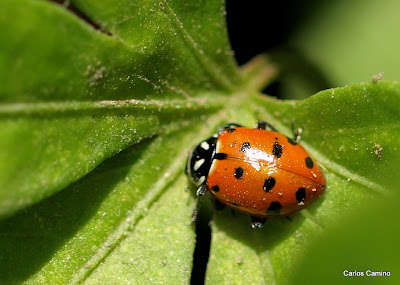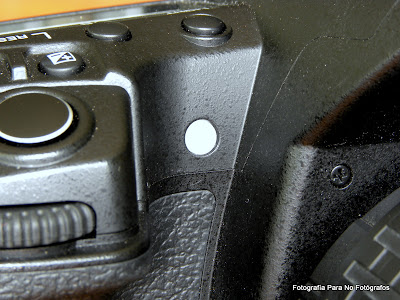The Macro and close-up photography are inextricably in the territory of the tripod, focus on the macro can be something very rewarding or extremely frustrating. Make macro is a test of patience and trial and error. But once you have mastered the techniques to photograph this microcosm, when we fall note that a neglected garden 2 x 2 m can be an endless source of subjects to be photographed, our way of seeing the world is going to turn around 180 degrees.
This post is not a guide to macro, is more like a set of tips on how to get started.
A couple of recommended books (purchased in Lima):
Close-Up & Macro, a photographers guide (Robert Thompson)
Digital Photography
Approach (Michael Freeman)
Here are some links:
Macrofotografía.ORG
Fotonostra: The Macro
Botanical - On Line (Macro techniques)
macro examples in Picasa Web Albums
There are many ways to address this activity, but there are some problems that we must overcome first, one of our main enemy is the wind, very soft this is, once we begin to "macro" walk in the world with a different perspective, with a visual acuity worthy of a lynx, walk facing plants, every speck on the wall, hoping to find some rare bird, a flower so interesting.
Well, suppose you have encountered a strange and colorful insect on a leaf, at the park near our house, we mount the camera on the tripod and we have to take that approach we have displayed in spectacular our minds ... is where we are going to realize that there are close links between the actions of mounting the camera, see the lighting, compose the frame and focus, and once we're ready to shoot, which begins a gentle breeze that makes it impossible take a picture. And this ... always will be (looks like a process automatically set.)
We have three scenarios to start taking macroftotografías, but regardless of the type of camera, we will need a tripod is VERY stable and desirable a GOOD tripod table, I have a Manfrotto Table Tripod with Mini Ball Head head is something heavy (very desirable), very stable and very good quality.
The first stage is to do macro with a pocket camera (point & shoot), I ONLY Lumix LZ8 example is my daughter, a basic model with good benefits (for the price, of course).
The tripod-mounted LZ8
cameras in girls there is a design feature that often makes it impossible Using a lightweight tripod, this is the thread that is off-center loading and the weight of the camera to one side. The weight of the tripod is on our side.
The tripod mount is out camera center
The following are pictures taken with this camera:
To make macro shots must activate this feature in the camera, this is identified by a flower, and adjust as necessary in the optical system to allow for a closer.
Normally in pocket cameras,
can not activate the zoom to take a shot in macro
this should be in the wide-angle, not tele.
The second stage, and better than the last to start, is a bridge or prosumer camera, this camera is bigger, with better optics and usually with better features, but what really helps a lot for macro, is to accept an accessory tube that put zoom lenses (not all models have this capability).
Pongo as an example of this category of my wife Lumix FZ8 is a late 2007 model, but still takes very good pictures.
Lumix FZ8
Comparison with the FZ8 LZ8
The Lumix FZ8 mounted on a tripod
This camera model has a thread where it gets support acrercamiento lens and filters.
tubular accessory to put filters and zoom lenses,
EYE! filters and lenses that are purchased must be the thread
to the diameter indicated in this case 55mm.
accessory attached to the camera
After installing the accessory, which is nothing but a pipe to length for the lens shift and the diameter standard threaded, we can proceed to place carefully, filters or zoom lenses in this case.
Usually these lenses, contact lenses or close up lenses, come in sets of three different measures: 1, 2 and 4 diopters, they allow the camera closer to the subject and allows for better filling the frame and therefore further expansion.
zoom lens set to 1, 2 and 4 diopters.
In this type of lens is a lot of qualities, this photo is a Sunpak of Chinese origin com many peripheral chromatic aberration, which forces them to keep the subject centered in the frame, the cost is around $ 15.00 play in USA. Some lenses are much better B + W , these are Germans, with far superior to those of the photo, I had some and were really good, with some minor aberrations at the edges, its cost is about $ 45.00 c / u. In my opinion the best are Canon , unlike those above have two elements (two lenses) instead of one, and its image quality much higher than those of a single item but its cost is about $ 130.00, well worth it.
attachment with a 4 diopter lens.
If you do not want to go to a scheme DSRL (cameras with interchangeable lenses), I think this is a good alternative, a camera like the Lumix FZ8 (a current model) to accept this accessory tubular, and a zoom lens set how the B + W, or at least one of 4 diopters.
Some photos taken with this camera:
This is normal type of cameras that can zoom in macro, so one can take a photo from a distance, without disturbing the insect you want to photograph. For example, if we have a very small flower like this:
Some photos taken with this camera:
This is normal type of cameras that can zoom in macro, so one can take a photo from a distance, without disturbing the insect you want to photograph. For example, if we have a very small flower like this:
Compare the size of the flower with my finger
Take Closest focusing distance , 90 cm. with macro zoom
Shooting macro zoom lens approximation and a 4-diopter,
The minimum focusing distance is now 21 cm.
Note how far you can fill the frame with the flower.
Obviously I can do cutting flowers grow I would not have the photo, but this is to illustrate how the picture would be full resolution, so i can see clearly the effect of the zoom lens in the frame.
addition, the Macro has other enemies in that level of amplification can not take good macros by hand, since even small movements, how the heartbeat will make our pictures come out "moves." .. solution? ... ALWAYS use a tripod, and make the shot using the camera's timer (if possible).
Another great enemy is the small depth of field, the space before and after the focus, which still maintains an acceptable sharpness. If your camera has manual functions, make possible more closed opening (f: 8 or less) and get good lighting.
The third scenario scheme is to enter a DSLR, this is the most expensive, but it is the best way to do macro, because while we can use one of those Canon lens on our approach normal lens, we are able to buy a specific macro lens, since the sensor size and sharpness of the lenses in these cameras, the macros are going to come out spectacular (when mastered the subject.) Obviamentevamos need a good tripod normal size as a table is not enough for the weight of one of these cameras.
We should note that a zoom lens for $ 130.00 is a lot cheaper than a macro lens and is a good solution as a board intermadia money for that lens, another element that helps us get closer still extension tubes, which are placed between the camera and lens focusing distances get shorter still.
Here the comparison of a bridge camera with a mid-range DSLR:
photos with the Lumix FZ8 Olympus E3 with a lens "normal"
The Olympus is superior in size, higher weight and higher price,
incomparable But its performance is superior,
well as other cameras in the same category as other brands.
As this is a camera DSLR (Digital Single Lens Reflex), it is possible to buy a specific macro lens, here is one:
Zuiko Lens Olympus 50 mm (100 LFE) MACRO f: 2.0
The Olympus E30 with macro lens
addition there specific macro flashes all costs, this is a Vivitar not very expensive, although not the ideal flash, it helps in macros:
This ring flash is screwed onto the macro lens
The flash put on macro lens Olympus E30
An additional advantage is that these cameras can use remote triggers to prevent movement of the same, here are some photos taken with this camera, I have many on hand, and I are rescuing a hard drive without back up:
Detail of Iris
Mariquita in Canta (Peru)
Small flower ants and a spider (Dominican Republic)
Mantis religiosa (Safford - USA)
Orchid dwarf (Dominican Republic)
Flies doing their thing (Peru)
Some pictures with flash override:
Fingerprint
Details of our ticket ten suns,
look well in the shade around Quiñones.
microprinting Detail in the shadows,
the right side of the image of Quiñones.
For those living in Peru, I put a detail of a ticket for 20 soles (búsquenlo!):
ticket details 20 Peruvian soles, the actual size is 3x3 mm.
Taken with an Olympus E30 with macro lens photo above.
Well!, After this long post, and hoping to inspire more than one, I leave to the next post.































































